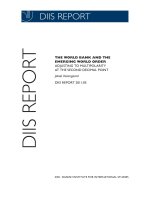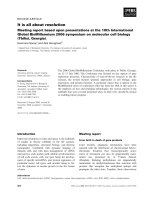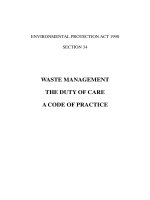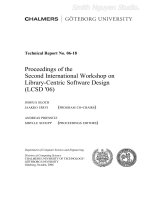The emerging International Polar Navigation Code bi-polar relevance
Bạn đang xem bản rút gọn của tài liệu. Xem và tải ngay bản đầy đủ của tài liệu tại đây (127.12 KB, 19 trang )
11 The emerging International Polar
Navigation Code: bi-polar relevance?
.
Throughout history, ships have been the principal means for reaching the
remotest regions of the world ocean. Such is the case at the end of the twentieth
century as ships carry scientists, explorers, commercial fishermen and tourists,
among others, to remote areas in the Southern Ocean and the Arctic Ocean. Since
1977, polar icebr
eakers have made an impressive total of twenty-eight vo
yages to
the North Pole for science and tourism.
1
Such access to the central Arctic Ocean by
surface ship would have been unthinkable only thirty years ago, when the Arctic
Ocean was consider
ed the domain of the nuclear submarine. In the Antar
ctic ships
carrying tourists have circumnavigated the continent,
2
and thousands of people
have visited the Antarctic Peninsula and the Ross Sea region by tourist ship. These
voyages of discovery and adventure reflect unprecedented ship access to nearly all
polar marine waters. Thus, it should not be surprising that national and interna-
tional regulatory bodies have initiated the development of construction and
navigation standards for polar ships.
What basic factors make ship navigation in polar waters unique com-
pared to all other ship voyages across the global ocean? Obviously, polar waters are
located at the extremities of the world ocean, generally remote from the centres of
human civilisation and from the normal availability of port services and rescue
capability. Polar waters are also among the least charted marine regions on earth.
Further, the Arctic and Southern Oceans are perennially cold, with water tempera-
tures near freezing, and human survival within such waters is exceedingly limited.
244
1
Remarkably, twenty-one of these North Pole voyages have been with tourists sailing aboard
Russian icebreakers. During 1977–99 polar icebreakers from Russia, Sweden, Germany, Canada
and the United States have reached the North Pole.
2
J. Splettstoesser, R. Headland and F. Todd, ‘First Circumnavigation of Antarctica byTourist Ship’,
Polar Record, Vol. 33, 1997, pp. 244–5.
Above all, the principal difference between polar waters and the remaining oceans
is the presence of sea ice formed through the freezing of sea water. On a global
scale, 7 per cent of the earth’s surface is covered by sea ice at some time each year.
3
As shown in Figure 11.1, in the Arctic Ocean the average winter maximum
extent of sea ice extends well beyond the central Arctic Ocean as such – covering
the Canadian Archipelago, the Russian Arctic including regions of the Barents Sea,
Baffin Bay, the Greenland Sea, the Sea of Okhotsk and much of the Bering Sea. The
Arctic sea ice area fluctuates between 9 million km
2
(summer) and 15 million km
2
(winter).
4
The summer minimum represents the approximate area of multi-year
ice that remains in the central Arctic Ocean.
5
In the Southern Ocean, the maximum
extent of sea ice occurs in September and surrounds the Antarctic continent north
of 55° to 65° South. The fluctuation of sea ice area in the Southern Ocean is consid-
erably greater than in the Arctic Ocean – 3 million km
2
(summer) to 20 million km
2
(winter) – and varies from 1.5 to 10 per cent of the Southern Ocean surface.
6
This
variability is due primarily to the open boundary north of the Antarctic coast that
allows most of the sea ice to melt during the austral summer.
Ice in all its forms – sea ice and floating glacial ice (icebergs) – presents a
formidable obstacle to sur
face ships operating anywhere in polar waters
. Usually
such ships require specialised design, added hull strengthening and increased pro-
pulsive power. Even ships that are not attempting to break ice, or do not intend
passage through ice, should have adequate hull strength, since they may become
trapped in drift ice (and be subject to potential damage by the surrounding ice
under pressure of the winds and currents). As indicated in Figure 11.1, there are
vast regions of open water during the summer minimum extent of sea ice sur-
rounding Antarctica. Most Antarctic research and support ships as well as tourist
ships operate near the coast during January through March, so as to maximise their
access to the continent. However, low visibility, frequent icebergs and substantial
fast ice are predominant conditions in most Antarctic coastal regions. There are
very few areas where a ship will not encounter ice in some form. Highly variable
and rapidly changing weather and sea ice conditions make Antarctic ship opera-
tions challenging and always demanding of a tenacious emphasis on safety. The
remoteness of Antarctica and the normally independent oper
ation of ships in the
region require that special consideration be given to ship and crew survivability in
such an extreme environment.
The land-locked nature of the Arctic Ocean, with only one major opening
for sea ice export (between Svalbard and Greenland), results in substantial ice
remaining in many Arctic coastal seas for long periods each year. Sea ice and ice-
bergs are also confined by the large island groups that surround the Arctic basin
The emerging International Polar Navigation Code 245
3
W. Weeks, ‘Sea Ice’, Encyclopedia of Earth System Science, Vol. 4 (New York: Academic Press, 1992),
p. 41.
4
Ibid.
5
Multi-year ice is also found along the northern Greenland coast and around the northern islands
of the Canadian Arctic.
6
Weeks, ‘Sea Ice’, p. 41.
(see Figure 11.1). Many of the passages between the islands, particularly in the
Russian and Canadian Arctic regions, remain partially ice-covered throughout
much of the year. Many traditional navigation routes can be ice-covered even
during the Arctic summer. In several respects, ice navigation in the central Arctic
Ocean can be more demanding than Antarctic operations because of the greater
extent of summer sea ice. The presence of thick, multi-year ice in the central Arctic
Ocean that on occasion intrudes into the coastal seas also influences the need for
higher-class polar ships and for additional design requirements. Due to the sea-
sonal melting of sea ice, a short navigation season, mostly in open water, is possi-
ble in several Arctic coastal regions – among them Hudson Bay, around Greenland,
Svalbard, along the western Alaskan coast and in the southwest Kara Sea.
Navigating in polar waters requires the availability of reliable and timely
information on the location of the surrounding sea ice and forecasts of any near-
term changes. Ice (and weather) information can be obtained from national ice
centres, local observations, and real-time satellite imagery received directly aboard
ship. In many polar regions, ships will sail around and avoid areas of more difficult
ice conditions by using all available environmental information. During most
Antarctic operations, this is a safe and effective strategy of route planning. In the
Arctic, however, many navigation straits and coastal seas are constrained by geog-
raphy; polar ships are either escorted by icebreakers or are forced to navigate inde-
pendently through areas of considerable ice. Undoubtedly, future polar ships will
have the capability of acquiring better ice information, which in turn will improve
the effectiveness and safety of ice navigation.
Significantly, strategies to enhance marine safety by the establishment of
navigation and construction standards for polar ships were pursued byseveral cir-
cumpolar nations prior to the era of the LOS Convention and the formulation of
its Article 234. For more than three decades, Russia and Canada developed exten-
sive regulatory and control systems for Arctic shipping. Russia’s system for naviga-
tion along the N
orthern Sea Route includes the issuance of ice passports
(certificates) to commercial ship classes.
7
Close operational control of all ships,
with or without icebreaker escort, remains a hallmark of the Russian system.
8
Canada’s ice-regimes shipping system designates zones for seasonal ice navigation
byships of varying ice class. Specific structural standards for polar ship classes are
integral components of both the Russian and the Canadian approaches. Detailed
and refined rules for ice-going ships in the Baltic Sea have also been developed,
246 Lawson W. Brigham
7
Guide to Navigating Through the Northern Sea Route (St Petersburg: Head Department of
Navigation and Oceanography of the Ministry of Defence of the Russian Federation, 1996), p. 319
(hereinafter NSR Guide). On Russian legislation and practice relating to navigation along the NSR,
see Brubaker, Chapter 10 in this book.
8
NSR Guide, pp. 84–9.
The emerging International Polar Navigation Code 247
Figure 11.1 Extent of sea ice in the polar oceans
principallybySweden and Finland. In recent decades, most ship classification
societies have developed their own ship construction rules for Arctic and Antarctic
operations.
9
By the early 1990s, the resulting efforts of national maritime authorities
and ship classification societies had left a non-uniform, patchwork set of rules and
regulations for ships navigating in ice. The multiple domestic systems with a range
of different ship ice-classes were clearly incompatible with the internationalisation
of the marine shipping industry, including the emerging international tourism
trade in polar waters. Most critically, ship and mariner certificates were not readily
transferable among nations or between classification societies. Fortunately
Germany (in 1991, for safety issues) and Russia (in 1993, for discharge issues) pro-
posed to the International Maritime Organisation (IMO) initiatives for the develop-
ment of supplemental polar rules for SOLAS, MARPOL 73/78 and other
conventions and codes. The IMO agreed that an Outside Working Group (OWG) of
technical experts should explore the development of specialised polar r
ules
. Since
1993 Canada has led what has become known as the polar ship ‘harmonisation
process’, an international effort to establish unified standards and rules.
10
Bi-annual meetings of the OWG in 1993–7 were held in Canada, Finland,
Germany, Norway, Sweden, Russia and the United States. From the outset, various
keystakeholders were active and influential participants in the open fora of the
harmonisation process. Included were members of national and regional maritime
authorities, ship classification societies, commercial ship operators, and research
and academic specialists.
11
Since the primaryemphasis of the effort was on devel-
oping a practical instrument for safetyand environmental protection, most partic-
ipants had either technical expertise (ship design, engineering and construction)
or polar operation experience. Both backgrounds were essential to crafting the
details of a workable bodyof polar ship rules. Unlike the LOS Convention and other
notable international maritime efforts, the harmonisation process was led by
marine practitioners with polar expertise: while diplomats and legal experts were
at times present and active during the proceedings, the drafting of the polar rules
was conducted bymaritime professionals. Sixteen nations, manywith active bi-
248 Lawson W. Brigham
19
Examples of the ship classification societies include the American Bureau of Shipping, Bureau
Veritas (France), Det Norske Veritas, Germanischer Lloyd, Lloyd’s Register of Shipping and the
Russian Register of Shipping.
10
Canada’s leadership coming from within Transport Canada.
11
Examples of national maritime authorities participating in the harmonisation process include the
Canadian Coast Guard, Transport Canada, the Government of the Northwest Territories, the
Icelandic Maritime Administration, the Finnish Maritime Administration, the Danish Maritime
Authority, the Swedish Maritime Administration, the Australian Maritime Safety Authority, the US
Coast Guard, the Ministry of Transport of the Russian Federation (Northern Sea Route
Administration), and the Norwegian Maritime Directorate.
polar interests, participated bysending experts or providing material during the
deliberations of the OWG.
12
The main objective of the harmonisation process was to create a com-
prehensive, unified code of rules for ships navigating in Arctic and Antarctic waters
– the ‘International Code of Safety for Ships in Polar Waters’ (Polar Code) as sub-
mitted to the IMO in the spring of 1998.
13
A key strategy of the OWG was to build
upon existing IMO ship rules.
14
The Polar Code was never intended to duplicate or
replace existing standards for international safety, pollution prevention and train-
ing. The additional measures of the Polar Code focus specifically and equally on
the safety of human life and the protection of the marine environment. From the
early deliberations of the OWG, several guiding principles, endorsed by the IMO,
have shaped development of the draft Code:
1. ships are to have suitable ice strengthening for their intended voyages;
2. no oil shall be carried against the outer shell;
3. all crew members are to be properly trained in the operation of polar
vessels;
4. appropriate navigational equipment shall be carried;
5. suitable survival equipment shall be carried for each person;
6. a unified method of classifying ice conditions is to be used; and
7. consideration of vessel installed power and endurance must also be
made.
A second, significant strategy of the OWG was to separate development of the Polar
Code – the generalised description of the harmonised polar ship rules – from par-
allel work by the International Association of Classification Societies (IACS) on the
detailed specifics of hull and machinery requirements.
15
The IACS unified set of
rules would eventually include a single set of international ice classes for ships,
detailed hull structural requirements and specific engineering systems require-
ments for polar ships. Thus, as technology evolves, the IACS uniform rules can
The emerging International Polar Navigation Code 249
12
The nations involved in the harmonisation process are Argentina, Australia, Canada, Chile,
Denmark, Finland, France, Germany, Iceland, Italy, Japan, Norway, Russia, Sweden, the United
Kingdom and the United States.
13
The draft Polar Code was submitted by Canada, on behalf of the OWG, to the IMO Sub-Committee
on Ship Design and Equipment, 41st Session in London, March 1998.
14
Notably, the 1973 International Convention for the Prevention of Pollution from Ships as modified
by the Protocol of 1978 (MARPOL 73/78); the 1974 International Convention for the Safety of Life
at Sea (SOLAS); and the 1978 International Convention on Standards of Training, Certification and
Watchkeeping for Seafarers (STCW).
15
The IACS, representing the major independent ship classification societies, includes 90 per cent
of the world fleet by tonnage. IACS members conduct more than 500,000 ship surveys each year
(by 6,000 surveyors and 3,700 technical staff). IACS roles include a classification role, i.e. inde-
pendent assessment of the integrity and mechanical ability of the ship for the intended purpose;
and a statutory certification role, i.e. as certifying agent under delegated authority from a mar-
itime administration for requirements of international and national instruments. IACS clients
include shipowners, states, designers, shipyards, manufacturers, underwriters, financiers,
charterers and cargo interests.
adjust and adapt, leaving the broad rules of the IMO Polar Code essentially
unchanged. This fundamental separation agreed to by the national maritime
authorities, the IMO and the IACS governing body allowed the bi-annual harmon-
isation meetings to proceed smoothly with drafting the Polar Code. An IACS ad hoc
group organised work and discussions on detailed technical issues.
Developments related to navigation and polar mariner certification have
also had an important influence on the evolution of the Polar Code. A harmonisa-
tion working sub-group focused on the navigation and training elements of the
proposed Code. Key topics included a certification process for ice pilots, an inter-
national ice navigators’ course, and future ice simulator training requirements. In
addition, a new organisation, the Circumpolar Advisory Group on Ice Operations
(CAGIO), was formed during the harmonisation process.
16
CAGIO was established
by the national administrations which have responsibility for domestic ice-covered
waters and which may also operate polar ships in their respective national inter-
ests. As a unique international forum for discussion of bi-polar ice operations, its
birth at the end of the century can be attributed partially to the end of the Cold War,
which has allowed the full participation of the Russian Federation. In the future,
CAGIO can act in a consultative role to the IMO, the Arctic Council and other polar
and maritime organisations.
17
A major theme of this book focuses on the integration of legal and policy
approaches at various levels (global, regional, sub-regional, national) to protecting
the polar marine environment. In essence, the aforementioned harmonisation
process is uniquely illustrative of integrated global cooperation – among the OWG,
IMO, CAGIO and IACS. Significant cooperation is evident within the process
betw
een public (the IMO and national administrations) and private (the IACS and
commercial shipping) institutions. There was also a unity of purpose among the
national maritime administrations and the IACS to develop polar ship standards
adhering from the beginning to a ‘precautionary approach’.
18
The key stakeholders
all recognised the potential risks associated with increased bi-polar shipping and
were committed to produce a functional and timely draft instrument for IMO
consideration.
Table 11.1 is a brief outline of the structure and components of the draft
Polar Code, as submitted to the IMO in March 1998. In the Preamble, linkage of the
250 Lawson W. Brigham
16
The founding members of the CAGIO were Canada, Finland, Norway, Sweden, Russia and the
United States.
17
CAGIO Terms of Reference, November 1996.
18
In the core of the precautionary principle is an anticipatory or preventive approach, a key facet of
the Polar Code. While acknowledging that uncertainty is unavoidable, this principle also stipulates
that uncertainty (with regard to environmental impact) should not be used as an escape to delay
or avoid the development and implementation of protection strategies or measures. For further
discussion of the precautionary principle in the context of the theme of this book, see especially
VanderZwaag, Chapter 8; also Boyle, Chapter 1, Rothwell, Chapter 3 and Vidas, Chapter 4 in this
book.









